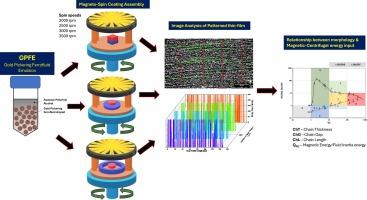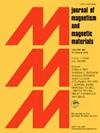Fabrication with magnetic-spin coating: Influence of magnetic-inertia energy ratio on gold-pickering ferrofluid droplet assembly morphology
IF 2.5
3区 材料科学
Q3 MATERIALS SCIENCE, MULTIDISCIPLINARY
引用次数: 0
Abstract
Magnetic self-assembly of nanoparticles is a well-known technique for creating thin-film array-patterned functional microstructures. However, an uncontrollable hierarchical assembly formation of magnetically stimulated particles has hindered the desired formation of free-standing two-dimensional (2D) array patterns in thin-film layers. In this study, we proposed a fluidic shearing effect from spin coating to reduce the magnetically stimulated particles’ disarrayed and complex chain formations. This would thus promote linear array formations, even as the film becomes thinner. A series of tests were conducted on a gold-pickering ferrofluid emulsion (GPFE) dispersed in 15.2 mPas aqueous polyvinyl alcohol (PVAh) under varying spin speeds and magnetic setups such as single (SI), compound (CC), and concentric (CR). These setups were chosen to observe the influence of magnetic field strength and distribution on the generated pattern profile from microscopic binary images of the resulting thin films. The aim was to quantify the formed chain thickness (ChT), chain gaps (ChG), and chain lengths (ChL) to capture the morphology and geometrical features of the formed patterns. Our results showed that the quantified values of these profiles and their dimensionless relationships were significantly influenced by the ratio between the applied magnetic packing energy and the centrifugally controlled fluidic energy, QPD. This investigation showed that ChT/ChG for a corresponding QPD value is 98.6% the same for all configurations, and CR was the best setup going forward, as it yielded the lowest array quality defectivity of 14%. Therefore, we assert that this fabrication method offers flexibility, cost-effectiveness, and expandability in generating linear array patterns that contain graduating variability in grating order dimensions within a single cast that can serve efficiently as a substrate for biomolecules under enhanced Raman and Infrared spectroscopies.

利用磁旋涂层制造:磁惯性能量比对挑金铁流体液滴组装形态的影响
纳米粒子的磁性自组装是一种众所周知的用于创建薄膜阵列图案功能微结构的技术。然而,磁激励粒子不可控的分层组装形成阻碍了薄膜层中独立二维(2D)阵列图案的理想形成。在这项研究中,我们提出利用自旋涂层的流体剪切效应来减少磁激励粒子的杂乱和复杂的链状结构。因此,即使薄膜变薄,也能促进线性阵列的形成。我们对分散在 15.2 mPas 水性聚乙烯醇(PVAh)中的挑金铁流体乳液(GPFE)进行了一系列测试,测试条件包括不同的旋转速度和磁性设置,如单一磁性设置(SI)、复合磁性设置(CC)和同心磁性设置(CR)。选择这些设置是为了观察磁场强度和分布对生成薄膜的显微二元图像所产生的图案轮廓的影响。目的是量化形成的链厚度 (ChT)、链间隙 (ChG) 和链长度 (ChL),以捕捉形成的图案的形态和几何特征。我们的结果表明,这些剖面的量化值及其无量纲关系受到应用磁性填料能量与离心控制流体能量 QPD 之间比率的显著影响。调查显示,在所有配置中,相应 QPD 值的 ChT/ChG 值相同,为 98.6%,而 CR 是未来的最佳设置,因为它产生的阵列质量缺陷率最低,为 14%。因此,我们认为这种制造方法在生成线性阵列图案方面具有灵活性、成本效益和可扩展性,在单个铸模中包含光栅阶次尺寸的渐变性,可在增强拉曼光谱和红外光谱下有效地用作生物分子的基底。
本文章由计算机程序翻译,如有差异,请以英文原文为准。
求助全文
约1分钟内获得全文
求助全文
来源期刊

Journal of Magnetism and Magnetic Materials
物理-材料科学:综合
CiteScore
5.30
自引率
11.10%
发文量
1149
审稿时长
59 days
期刊介绍:
The Journal of Magnetism and Magnetic Materials provides an important forum for the disclosure and discussion of original contributions covering the whole spectrum of topics, from basic magnetism to the technology and applications of magnetic materials. The journal encourages greater interaction between the basic and applied sub-disciplines of magnetism with comprehensive review articles, in addition to full-length contributions. In addition, other categories of contributions are welcome, including Critical Focused issues, Current Perspectives and Outreach to the General Public.
Main Categories:
Full-length articles:
Technically original research documents that report results of value to the communities that comprise the journal audience. The link between chemical, structural and microstructural properties on the one hand and magnetic properties on the other hand are encouraged.
In addition to general topics covering all areas of magnetism and magnetic materials, the full-length articles also include three sub-sections, focusing on Nanomagnetism, Spintronics and Applications.
The sub-section on Nanomagnetism contains articles on magnetic nanoparticles, nanowires, thin films, 2D materials and other nanoscale magnetic materials and their applications.
The sub-section on Spintronics contains articles on magnetoresistance, magnetoimpedance, magneto-optical phenomena, Micro-Electro-Mechanical Systems (MEMS), and other topics related to spin current control and magneto-transport phenomena. The sub-section on Applications display papers that focus on applications of magnetic materials. The applications need to show a connection to magnetism.
Review articles:
Review articles organize, clarify, and summarize existing major works in the areas covered by the Journal and provide comprehensive citations to the full spectrum of relevant literature.
 求助内容:
求助内容: 应助结果提醒方式:
应助结果提醒方式:


